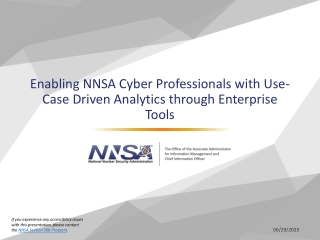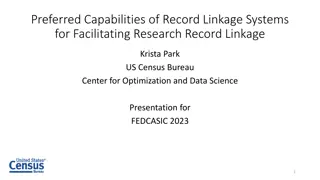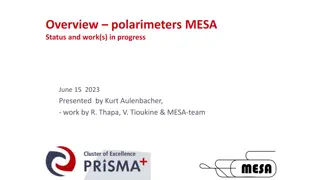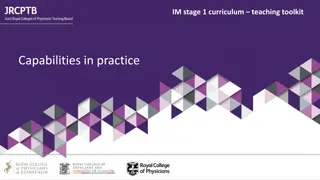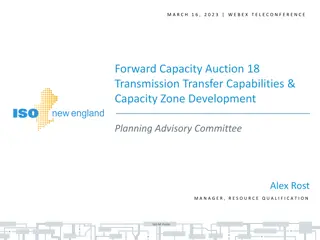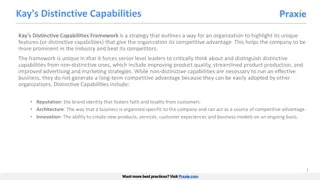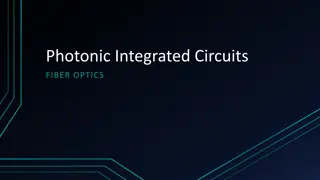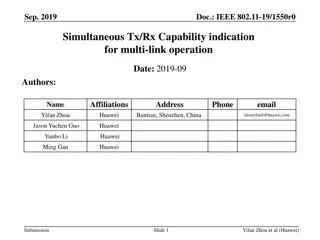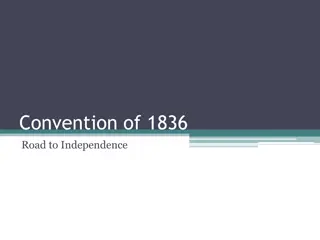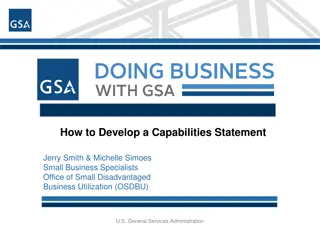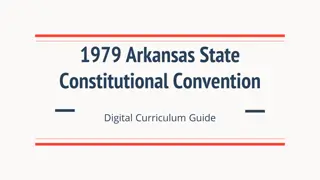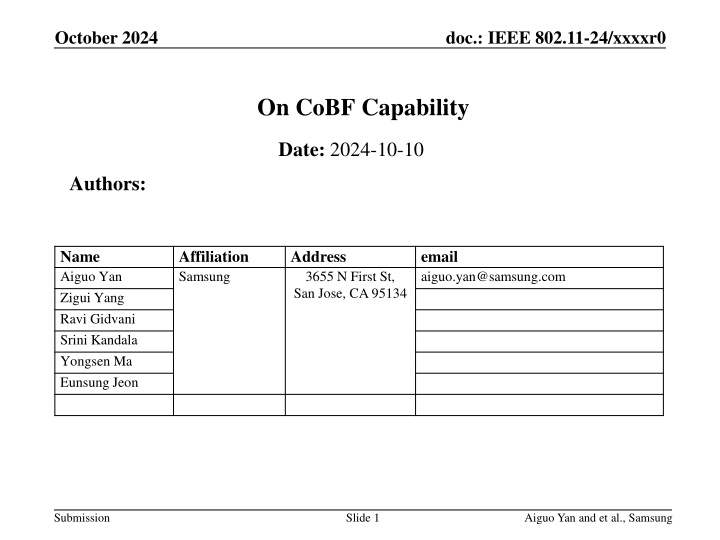
IEEE 802.11-24 CoBF Capability Discussion Highlights
Explore the key points from the October 2024 IEEE 802.11-24 meeting regarding Coordinated Beamforming (CoBF) capabilities. Delve into discussions on maximal number of users, total streams, and NSTS per AP. Discover the balance between simplicity and WiFi advancement in CoBF implementations.
Uploaded on | 0 Views
Download Presentation

Please find below an Image/Link to download the presentation.
The content on the website is provided AS IS for your information and personal use only. It may not be sold, licensed, or shared on other websites without obtaining consent from the author. If you encounter any issues during the download, it is possible that the publisher has removed the file from their server.
You are allowed to download the files provided on this website for personal or commercial use, subject to the condition that they are used lawfully. All files are the property of their respective owners.
The content on the website is provided AS IS for your information and personal use only. It may not be sold, licensed, or shared on other websites without obtaining consent from the author.
E N D
Presentation Transcript
October 2024 doc.: IEEE 802.11-24/xxxxr0 On CoBF Capability Date: 2024-10-10 Authors: Name Aiguo Yan Zigui Yang Ravi Gidvani Srini Kandala Yongsen Ma Eunsung Jeon Affiliation Samsung Address 3655 N First St, San Jose, CA 95134 email aiguo.yan@samsung.com Submission Slide 1 Aiguo Yan and et al., Samsung
October 2024 doc.: IEEE 802.11-24/xxxxr0 Outline 1. CoBF was already motioned in July, 2024 meeting for 11bn. 2. But there are still a lot of discussions on CoBF capability, specifically a) Maximal total number of Users. b) Maximal number of total Streams. c) Maximal NSTS per AP. Also related to sequential/joint sounding discussions 3. We will share our thoughts on these 3 numbers, and plan to run one straw poll. 4. One key point: Find the best balance between simplicity and WiFi advancement Submission Slide 2 Aiguo Yan and et al., Samsung
October 2024 doc.: IEEE 802.11-24/xxxxr0 Numbers of APs and STAs in CoBF 1. It has been widely agreed that # of APs in CoBF is 2. 2. Discussions on total # of STAs a) 4. We believe that this a very balanced #, for both complexity and Wi-Fi advancement. b) 2 for simplicity. But is it too simple? 3. Possible Combination of 4 Users (see algorithm in [8]) a) (2,2), (3,1), (1,3) (2,1), (1,2),(1,1), up to CoBF APs to choose. Submission Slide 3 Aiguo Yan and et al., Samsung
October 2024 doc.: IEEE 802.11-24/xxxxr0 Number of Total Streams 1. We also believe that 4 is a very reasonable number, 2. Possible Combination of up to 4 streams (see also algorithm in [8]): a) (2,2), (3,1), (1,3) (2,1), (1,2),(1,1) b) However, we also believe limiting to 2 streams/STA is another good balance. 3. In summary, CoBF supports up to 4 users and up to 4 streams has no ambiguities Submission Slide 4 Aiguo Yan and et al., Samsung
October 2024 doc.: IEEE 802.11-24/xxxxr0 NSTS per AP Sequential Sounding 1. Since 11ax/be already, 11bn will, support up to 8 spatial streams (NSTS) for APs, it is very desirable for CoBF to also support up to 8 spatial streams (NSTS) per AP. [Table 36-43 of 11be D7.0] 2. Both Sequential and Joint sounding are proposed for CoBF [5-7]. 3. For the sequential sounding of CoBF, it seems nature to limit NLTF = 4, 6, and 8, in order to accommodate NSTS = 4, 5, 6, 7, and 8. 4. This choice of NLTF values can also be considered as an nature extension of NLTF values from the existing HE/EHT sounding schemes. Submission Slide 5 Aiguo Yan and et al., Samsung
October 2024 doc.: IEEE 802.11-24/xxxxr0 NSTS per AP Joint Sounding (1/2) 1. Both full-rank and partial-rank nulling are proposed for CoBF. 2. [2,3,4,6] have shown the partial-rank nulling is preferred in many scenarios for better performance. 3. Joint sounding are especially proposed in order to better enable CoBF with partial-rank nulling. 4. The joint sounding with total NSTS = (4+4) definitely makes sense [7]. 5. However, the joint sounding with up to total NSTS = (8+8) demanding further discussions. Submission Slide 6 Aiguo Yan and et al., Samsung
October 2024 doc.: IEEE 802.11-24/xxxxr0 NSTS per AP Joint Sounding (2/2) 1. Furthermore for a STA, the joint sounding could lead to H = [H1, H2] having 16 columns 2. SVD(H) is needed for the partial-ranking nulling [4,5,6]. 3. On the other hand, there are proposals to do SVD(H1) and SVD(H2), and then feedback [8,9,10]. Therefore, CoBF APs could instruct a STA to do either SVD(H) jointly, or SVD(H1) and SVD(H2) separately. 4. Enabling different CoBF precoder designs is a good way to accelerate commercialization of the CoBF. 5. More discussions would be beneficial. Submission Slide 7 Aiguo Yan and et al., Samsung
October 2024 doc.: IEEE 802.11-24/xxxxr0 NSTS per AP 2 Different NSTSes 1. In order to increase chance of CoBF use, 2 APs in CoBF could have different original NSTS. 2. However, we do prefer a same NSTS/AP for simplicity. 3. Especially for the joint sounding, we believe that too many choices (i.e., 8 to 16) on total NSTS are not practical We believe that 2 choices of (4+4) and (8+8) are reasonable. 4. A simple/illustrative example to achieve same NSTS With AP1 , NSTS = 4 With AP2 , the original NSTS = 8 AP2 can reduce to NSTS = 4 with a spatial expansion method. Submission Slide 8 Aiguo Yan and et al., Samsung
October 2024 doc.: IEEE 802.11-24/xxxxr0 Summary 1. CoBF is a significantly big feature in UHR. 2. Careful balance of complexity vs WiFi advancement is beneficial. 3. We shared our thoughts on 1. Maximal total number of Users 2. Maximal number of total Streams. 3. Maximal NSTS per AP. Submission Slide 9 Aiguo Yan and et al., Samsung
October 2024 doc.: IEEE 802.11-24/xxxxr0 SP 1 Do you support the following: A CoBF transmission supports maximum total 4 users across the two APs A CoBF transmission supports maximum total 4 spatial streams across the two APs Y: N: A: [Note: 2 APs in CoBF already passed straw poll] Submission Slide 10 Aiguo Yan and et al., Samsung
October 2024 doc.: IEEE 802.11-24/xxxxr0 Reference [1] 23/1998: Zero-MUI Coordinated Beamforming (Shimi of Huawei) [2] 24/1204: Coordinated Beamforming for 11bn (Insik of LGE) [3] 24/1515: Coordinated-Beamforming-for-11bn-follow-up (Insik of LGE) [4] 23/0776: Performance of C-BF and C-SR (Ron of BRCM) [5] 24/1542: Sounding Schemes for Coordinated-Beamforming (Sameer of QCOM) [6] 24/1568: Sounding-Design-For-C-BF (Ron of BRCM) [7] 24/1582: Coordinated Sounding for CoBF (Youwei of MTK) [8] 24/1432: Unified-CoBF-and-MUMIMO-Schemes-with-Zero-MUI (Aiguo of Samsung) [9] 24/1653: Sounding Options for CoBF (Aiguo of Samsung) [10] 24/1789: CoBF: Partial Nulling Feedback Types (Rani of Huawei) Submission Slide 11 Aiguo Yan and et al., Samsung


